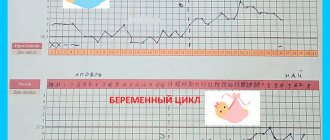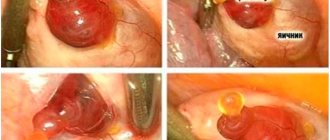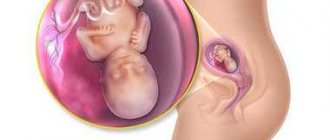It will be useful for every expectant mother to know what basal temperature is, how it is determined and what pregnancy pathologies it may indicate. It is enough to learn how to correctly analyze the basal temperature chart, including during a frozen pregnancy, in order to independently monitor at home possible failures during its course. Fertilization is indicated by a steadily increasing basal temperature over 10-14 days. During this period, BP levels up to 37°C in 9 out of 10 cases mean successful conception.
A frozen pregnancy is another matter. Can a mother suspect something is wrong even before visiting a doctor if she monitors the graph of changes in basal temperature? Freezing of the fetus always affects its performance. When a frozen pregnancy occurs in the early stages, the basal temperature rapidly drops. The body notifies the pregnant woman about the problem, demanding its immediate solution before complications occur.
BT and the theoretical side of the issue: what is useful to know
Doctors still trust methods for measuring basal temperature. A simple and affordable option to monitor the condition of the female body with control over the functioning of systems and organs allows you to respond to problems in the early stages.
Keeping a graph of basal temperature during planning and pregnancy is a huge plus for those who want to monitor changes in hormonal levels.
***
The observation is based on a special connection between the temperature in the rectum and vagina with the menstrual phase and hormones at one time or another. Despite minor fluctuations (up to 1.0 degrees) throughout the entire cycle they are natural.
The main reason for the predictability of changes is progesterone. The hormone promotes the development of the corpus luteum of the ovary with parallel “warming up” of organs and tissues. That is, when BT increases, progesterone is in the active stage; when it decreases, the hormone level drops.
What is done if you suspect a frozen pregnancy, what therapy is indicated
Of course, the subjective symptoms of a frozen pregnancy are the “marker” that notifies you of the need to immediately consult a doctor in order to conduct a thorough diagnosis. And if the diagnosis is confirmed using appropriate tests, the embryo is removed from the uterine cavity.
Sometimes the body itself gets rid of the frozen fetus - a spontaneous miscarriage occurs
Frozen pregnancy - treatment
Medical tactics for managing a woman with this pathology can be different: it depends on the gestational age, as well as the psychological and physical state of the pregnant woman.
If the diagnosis is made early, doctors often take a wait-and-see approach: there is a considerable probability that a spontaneous onset of miscarriage will occur. The woman is placed in a hospital setting under the supervision of specialists, and a spontaneous miscarriage is expected over the course of several days. But if this does not happen (this happens if the fetus died long enough), then an abortion is performed.
In particular, during early pregnancy, vacuum aspiration is often used - this is the safest method; for a period of less than 2 months, an artificial miscarriage is performed using appropriate medications.
And already in the later weeks of pregnancy, the frozen fetus is removed by cleaning the uterine cavity: the procedure is carried out under general anesthesia, and the resulting materials are sent for histological examination.
After which the woman remains in the clinic for some time: she is prescribed a course of antibiotics, hormone therapy (if there are indications), as well as sedatives. Hormonal tests are necessarily carried out, smears are taken for hidden infections, and general blood counts are identified using tests.
A woman may be prescribed hormones after a missed abortion
Frozen pregnancy - consequences for a woman
It is worth noting that serious complications in women occur only if she consults a doctor late. And a timely diagnosis, correctly prescribed treatment - all this in the future will help a woman become pregnant again and give birth to full-fledged offspring.
A particular difficulty in the case of a frozen pregnancy is determining the reason for its termination (unfortunately, this can only be established absolutely precisely in very rare cases), because every effort must be made to ensure that this does not happen again.
Many women who have already encountered this pathology are interested in whether a repeat frozen pregnancy is possible? Experts are unanimous in the opinion that this can be repeated more than once if the cause of fetal death has not been established.
Accordingly, a woman should approach solving the problem comprehensively: undergo a serious examination, visit a geneticist, and cure existing ailments. And, of course, the attitude towards a positive outcome of the next pregnancy is very important.
The loss of an unborn child is a heavy blow for any woman. This is reflected in her reproductive system, and, of course, on the psycho-emotional background. In such a difficult period, a woman urgently needs the support of loved ones, and possibly psychological help from a specialist. In any case, it will take a long time to accept what happened.
For every woman who wants to have a child, the miscarriage of pregnancy is a heavy blow.
Putting knowledge into practice
Having a regular thermometer for BT measurements at home, you can monitor the development of pregnancy and consult a doctor in a timely manner if you suspect any pathology. This is much more affordable and convenient than taking tests every day and is very important in the first trimester of pregnancy, when the most important changes in the body occur.
The menstrual cycle has 3 main phases:
- follicular;
- ovulatory;
- corpus luteum.
Progesterone works actively in the second and third phases, so it is quite easy to determine ovulation by increasing the basal temperature by 0.5 degrees.
It is noteworthy that progesterone levels help determine the onset of pregnancy almost accurately, almost immediately after conception. From the moment of fertilization, the hormone level will remain at one point for at least 12 weeks, and along with it, basal temperature indicators will also be steadily elevated.
When should you not believe testimony?
Data obtained during measurement do not always reflect the actual condition of the mother and fetus. The temperature may rise due to improper behavior of the woman. This way you can lose valuable time, which is dangerous for your health.
The following measurement errors lead to distorted results:
- Unsystematic measurement at different times of the day.
- Irregular monitoring of basal temperature.
- Recording values after loads. A period of active wakefulness or evening rest after a tiring day is not the best time for the procedure. Basal temperature is sensitive to activity, overwork of a woman, and her rises can be interpreted incorrectly.
- Incorrect position during the procedure. You cannot measure your temperature while sitting in bed, as it may increase due to blood flow to the pelvic organs.
- Having sexual intercourse. It is advisable to exclude them for the entire monitoring period. As a last resort, a minimum interval should be observed - rest after sex for at least 12-14 hours.
- Taking medications. In the early stages, they should normally be excluded so as not to harm the fetus. But sometimes a woman is forced to take them for health reasons. This also needs to be taken into account.
- Exacerbation of a chronic disease or acute pathology. A graph drawn up against a background of poor condition is not informative.
- Temperature measurement during stressful situations.
In addition to changes in temperature, other symptoms confirm the death of the fetus: all signs of early toxicosis quickly disappear, the enlargement of the mammary glands stops, pigmentation of the nipples disappears, cramping or constant nagging pain appears in the lower abdomen. Bloody or brownish vaginal discharge may occur, often with a foul odor.
You cannot rely only on basal temperature values, even if measured according to all the rules. A woman should not worry if her history before fertilization was below the average. In this case, low numbers often persist during pregnancy. This is possible against the background of normal fetal development. This is why temperature control is so important when planning pregnancy.
The following factors indicate the absence of pathology during examination:
- the doctor listens to the fetal heartbeat;
- the size of the uterus corresponds to the duration of pregnancy;
- Ultrasound results indicate normal fetal development;
- Blood and urine tests show normal concentrations of human chorionic gonadotropin; a general blood test shows no inflammatory changes.
What should the basal temperature be during a frozen pregnancy? Even with a normal course, temperature indicators are very individual; their low values do not always indicate pathology. This sign is secondary in the diagnosis of a frozen pregnancy, but the values of this indicator need to be known and monitored.
If you notice any deviations in the schedule, you need to contact the observing gynecologist, who will resolve all doubts. If a thorough examination confirms the fears, the pregnancy will be terminated. The main thing is that the woman’s health will not suffer and the next pregnancy will definitely end with the birth of a healthy baby.
Olga Shchepina, doctor, specially for Mama66.ru
What is a frozen pregnancy and how does it affect basal temperature?
A frozen pregnancy is called anembryony. Usually the process of stopping the development of the embryo occurs before the 28th week. It is very important to notice the pathology before the fetus begins to decompose, causing intoxication of the pregnant woman’s body.
***
Keeping track of your basal temperature chart during pregnancy should become a habit. Knowing clearly what the basal temperature was from the moment of planning and during pregnancy until the moment the baby is born will help you control the process and respond to possible failures by visiting a doctor.
With normal fetal development, basal temperature fluctuates between 37-37.7 °C. Stopping fetal development will invariably lead to a decrease in performance. A drop in BBT levels followed by a sharp increase can become a dangerous signal about the development of an inflammatory process against the background of a frozen pregnancy. At this stage, the health and even the life of the pregnant woman are at risk.
What basal temperature is considered normal and what is not?
On average, the basal temperature of a non-pregnant woman is 36.7. At a time when she herself may not yet feel the birth of the baby, the body is already giving signs - the basal temperature is rising. It rises to 37 degrees. Which is the norm throughout pregnancy.
What is the basal temperature during a frozen pregnancy ? In this case, the temperature drops to 36.7-36.9 degrees, that is, it becomes the same as that of a non-pregnant woman.
If you notice a low basal temperature during pregnancy, do not panic. As mentioned above, in addition to basal temperature, other factors need to be taken into account. In addition, basal temperature is often measured with errors. And even more often, mothers simply work themselves up out of nervousness, which is quite normal in their situation.
But still, if you have at least a few symptoms of a frozen pregnancy, you should contact an antenatal clinic. As a result of this disease, a woman can lose a child through miscarriage. But this doesn't always happen.
In rare cases, during a frozen pregnancy, the basal temperature, which sometimes remains at around 37, does not allow pathology to be traced. There are also cases when women’s basal temperature decreases, and at the same time pregnancy proceeds wonderfully.
As has already become clear, everything is quite individual, and you can’t guess at home. To avoid health problems in the present and future, you should be under the supervision of a doctor.
How not to miss a temperature drop?
To “keep your finger on the pulse,” doctors advise starting to keep a chart of changes in basal temperature from the moment of conception, and even better, ¾ of pregnancy planning. By tracking fluctuations in BBT, you will be able not to miss fertilization and monitor the gestation process. Only in this case will pregnant women be able to see the difference with a possible decrease in indicators as a result of fading pregnancy. Comparing the results, women will find a drop in BT data and will begin to delay visiting the doctor.
In addition to a decrease in basal temperature, a number of accompanying symptoms indicate the fading of pregnancy. These include:
- softening previously swollen mammary glands;
- cessation or reduction of manifestations of toxicosis;
- aching pain in the abdomen and lower back;
- dark discharge in small quantities.
All these signs, combined with a sharp drop in basal temperature, are a serious reason to urgently undergo an examination to exclude or confirm suspicions of a frozen pregnancy.
***
The diagnosis of a frozen pregnancy will require surgical intervention. The frozen fetus is removed from the uterine cavity by curettage. When asked how long the temperature lasts after the intervention, doctors answer: no more than 2-3 days, as a reaction to stress.
A few days later, the temperature must return to normal after curettage of a frozen pregnancy. A sustained increase in body temperature indicates complications with the development of the inflammatory process. At such moments, it is important not to think about antipyretics, ignoring the symptoms, but to urgently seek help.
Reasons for lack of fetal development
A non-developing pregnancy or failed miscarriage, as this condition is also called, is characterized by the lack of development of the fetus at some stage, after which it dies. This phenomenon is possible at any stage, but most often occurs before 13 weeks. The most critical are considered to be 3-4, 8-11 and 16-18 weeks. The measured basal temperature during a frozen pregnancy helps to promptly suspect this deviation based on its indicators during this period, since a decrease is observed.
The causes of this pathology:
- Infectious diseases;
- Tumors and inflammations in the uterus (fibroids, endometriosis, etc.);
- Hormonal disbalance;
- Diseases of the endocrine system (diabetes mellitus, problems with the thyroid gland);
- Unhealthy lifestyle, smoking, alcohol abuse;
- Not young (over 30 years old).
Basal temperature during a frozen pregnancy can arise not only as a result of gynecological or infectious diseases, but also from a disease of the endocrine system, or an unhealthy lifestyle in a woman over the age of 30.
Why does frozen pregnancy occur?
In the video review, the doctor will tell you in more detail about the causes of frozen pregnancy.
How does basal temperature change during frozen pregnancy?
At first, the development of pregnancy proceeds normally, temperature indicators do not go beyond the norm and remain within the range of 37.0-37.5 ° C, all other symptoms are noted:
- Delay of menstruation;
- Nausea;
- Breast tenderness;
- Positive test.
And therefore, basal temperature during a frozen pregnancy in the early stages is not entirely informative if everything happens before the delay and with a minimal set of symptoms. After all, without conception, a decrease in indicators normally begins a few days before menstruation. With such changes in the schedule, you can think about the failed fertilization and not attach any importance to them, thinking that your critical days will come soon.
But it is the decrease seen on the graph that is an important indicator in suspecting deviations, especially if you are confident that conception has occurred. It is advisable to conduct a highly sensitive test and, if the result is positive, visit a doctor.
Treatment in this case is medical abortion. At later stages, curettage is indicated. It all depends on the timing. After the procedure, fetal histology is performed to determine the cause of the pathology.
The cause must be eliminated before the next fertilization. The recovery period in this case is at least 6 months, and then it is possible to plan a new successful conception.
After a frozen pregnancy, the recovery period is at least 6 months.
The most dangerous period is up to 8 weeks. It is not always possible to sense the moment when the fetus has stopped developing. If the basal temperature drops during a frozen pregnancy, this is the first and most certain symptom.
A decrease in thermometer readings below 36.9°C after a delay and in the presence of a positive test requires immediate contact with a gynecologist. Perhaps the fetus has only slowed down its development and is still alive, then it can be preserved with timely inpatient treatment.
If the basal temperature drops during a frozen pregnancy for up to 10 weeks, it is necessary to verify the fact of interruption of fetal development by ultrasound or test the hormone for hCG levels.
Increased BT during pregnancy fading: what is the reason?
Measuring and tracking your basal temperature chart is an undeniable advantage for monitoring pregnancy, but you should not rely solely on results obtained at home. The problem with anembryonia is that it is not always accompanied by a low basal temperature. As already noted, fetal freezing can lead to an immediate inflammatory process. This will prevent BT indicators from falling and will be misleading.
Late identification of a problematic diagnosis will lead to miscarriage, often with dangerous consequences for health. Active contraction of the uterus will provoke detachment of the fertilized egg and cause profuse painful bleeding. And all this is at best. At worst, delay in identifying abnormal symptoms will lead to inflammation of the endometrium of the uterus with subsequent decomposition of the frozen embryo.
Being aware of what the temperature should be when pregnancy is fading (below 37 degrees), a woman will be able to notice a problem if it rises sharply. The stability of the indicators is manifested against the background of signs accompanying intoxication:
- spasms;
- headache;
- nausea;
- vomiting.
It is important that the pregnant woman does not confuse these symptoms with manifestations of ordinary toxicosis and consult a doctor.
***
Body signals that pregnancy is fading
Most women know that the basal temperature rises with the onset of pregnancy and remains this way for a long time. Wanting to know exactly about the onset of their interesting situation, many ladies regularly measure this temperature and keep its graphs. But today there are other, more modern and convenient methods for monitoring the development or non-development of the fetus. That is, let's define not only BT during pregnancy fading, but also other signs of its troubles.
2-3 weeks after pregnancy, most expectant mothers begin to notice changes in their bodies. First of all, this is the absence of menstruation and the development of toxicosis. Sometimes this is accompanied by pain in the mammary glands, their enlargement, swelling, and pigmentation of the nipples. Women begin to get used to these symptoms. If they suddenly or gradually begin to disappear, this should alert the woman. An abrupt cessation of toxicosis and disappearance of breast tenderness should attract the woman’s attention. If this is also accompanied by red-brown vaginal discharge, then we can certainly state that there is trouble during pregnancy.
Measuring basal temperature at home
Despite all of the above, it doesn’t hurt to monitor your basal temperature readings. To do this, make it a rule to regularly keep a schedule of readings from the moment you plan your pregnancy until the birth.
The essence of the method is to compare the results, so it is important to show maximum responsibility by recording readings during the cycle before conception and the next 3 months of the action of the progesterone hormone after.
The indicators need to be measured in this order:
- In the morning, immediately after sleep, without getting out of bed, take vaginal temperature readings (measure for 7-10 minutes).
- Record your readings on the calendar.
- Use one working mercury thermometer, do not change the insertion site (this can be the rectum or vagina).
- For convenience, lubricate the tip with Vaseline.
Insertion depth is up to 2 cm. Measurement duration is at least 7 minutes. It is strictly forbidden to take thermometer readings while sitting. Results will be inaccurate due to blood flow.
It is very important to take measurements daily to track any subtle changes in the first trimester, comparing them with the period before conception.
Typically, the thermometer shows a temperature in the range of 36.5-36.9°C. From the moment of ovulation, the data rises to 37.4 ° C, falling shortly before menstruation. Conception is indicated by a stable temperature within 37.1-37.5 °C, in some cases the increase reaches 38 °C.
***
A delay in menstruation against the background of an increase in basal temperature indicates a possible pregnancy. However, even if you decide to track data on changes in BT, remember that the baby’s health should not depend solely on the thermometer readings. A graph of basal temperature readings is not an alternative to a laboratory examination, but an auxiliary method. Indicators may change under the influence of alcohol, medications, stress, poor sleep and other errors.
The results of home monitoring are needed only in order to make an unscheduled visit to the doctor in case of suspected pathology.
A drop in BT levels during pregnancy: is it always necessary to sound the alarm?
Observing a decrease in basal temperature during pregnancy, the expectant mother can quite rightly fall into a state of panic. In fact, you shouldn’t get upset and worry ahead of time; it’s dangerous for your health.
The first thing you need to think about is how calm and correct the day before the measurements was in terms of adherence to the diet. Perhaps the evening turned out to be anxious and stressful, or perhaps, on the contrary, overflowing with new emotions and impressions against the backdrop of an unbalanced menu during a meeting with friends.
All these “little things” affect the basal temperature readings. In addition, a malfunction of the thermometer cannot be ruled out. Did you notice that something went wrong? First of all, try repeating the measurements (measure the temperature in the rectum for accuracy), use a new thermometer. If the picture doesn't change, don't panic until the next morning. Over the course of a day, temperature fluctuations caused by lifestyle errors the day before are normalized. If not, go to the doctor.
Method for determining basal temperature during pregnancy
The temperature is measured without getting out of bed, in a lying position. At the same time, it is important to move less. To comply with this condition, the thermometer is placed on the bedside table in the evening so that in the morning you can simply reach out and take it. The tip of the thermometer must be treated with any means that reduces friction. Vaseline, baby cream, oil will do.
To ensure the most accurate data, the thermometer is inserted into the anus or vagina. It is necessary to insert the tip of the device 2 cm deep and lie quietly for about 5 - 7 minutes. When monitoring temperature, the location of the thermometer insertion should remain unchanged. Moreover, all procedures are carried out by the same device, the serviceability of which is beyond doubt.
An electronic thermometer or mercury thermometer is suitable for measuring basal body temperature. The latter is considered more accurate.
Is it possible to detect an ectopic pregnancy using BT?
An ectopic pregnancy with the localization of the fertilized egg in the “wrong” place occurs for various reasons and at the initial stage of development manifests itself with the same signs as a healthy one:
- toxicosis;
- drowsiness;
- swelling of the mammary glands;
- reaction to smells and tastes, etc.
The same applies to basal temperature. The thermometer is not able to show where the fertilized egg is located. The mercury column only records the fact that conception has occurred and serious changes have occurred in the body. Special rapid tests to determine the level of hCG and examination by a doctor will help to detect an ectopic pregnancy in the early stages.
***
Features of measuring basal temperature during pregnancy
Knowing the mandatory conditions for measuring basal temperature, the expectant mother will always be confident that the results are correct.
To obtain reliable information, remember these rules:
- Measuring basal temperature makes sense only in the early stages of pregnancy. As the fetus develops, a woman's hormonal background undergoes significant changes, so temperature fluctuations are no longer as significant as in the first weeks of pregnancy.
- Measurements are taken in the morning, if possible at the same time. Basal temperature readings can be affected by food intake, so it is most convenient to use a thermometer immediately after waking up, before breakfast.
Pregnancy after miscarriage and basal temperature chart
Considering that maintaining a chart of basal temperature readings imposes certain obligations on the expectant mother, doctors do not require its mandatory maintenance. The exception is women with miscarriages and a history of pathologies. It is vital for them to control the process of a new pregnancy due to the high risk of recurrence of the situation.
Doctors strongly recommend monitoring the manifestation of other symptoms along with keeping a basal temperature chart. Pain and dark discharge should be the first thing to alert you to.
Indications for increased monitoring are age-related pregnancy. Women over 35 years of age should be especially responsible by monitoring basal temperature readings, listening to body signals, and not missing visits to the doctor for routine examinations.
Reasonable vigilance without excessive anxiety will help not to miss important symptoms. As for the information that after 40 women have “their own” temperature readings during normal and frozen pregnancies, this is not true. Also, when the fetus freezes, the level of progesterone drops, showing a temperature of less than 37 degrees and remains stably maintained during the first trimester during pregnancy without pathologies.
In conclusion, it remains to be noted that BT control is an archaic method of monitoring the development of pregnancy, but it is quite reliable and significant, especially for expectant mothers at risk. In addition, measuring basal temperature after cleansing after a frozen pregnancy will help identify possible complications.
How to diagnose a frozen pregnancy
The medical institution may offer several examination options. Each of them is effective and will allow you to accurately diagnose anembryonics.
- Ultrasound. By performing an ultrasound, the doctor will be able to check the baby’s heartbeat or lack thereof.
- Gynecological examination. The doctor will examine the patient, listen to the baby’s heartbeat, and in the case of a frozen pregnancy, detect a discrepancy in the size of the uterus.
- Urine or blood test for hCG. The hormone during a normal pregnancy is higher than during a frozen one.
A frozen pregnancy is not the collapse of all dreams of a happy family with children, no. This is something that happens to some women, but does not carry with it the terrible burden of infertility. After an unsuccessful pregnancy, it is quite possible to become pregnant again and give birth to a wonderful, healthy child. In just six months you can calmly work on your new baby. The likelihood that a frozen pregnancy will happen again is very low. And for greater confidence, mothers are advised to lead a healthy lifestyle.










